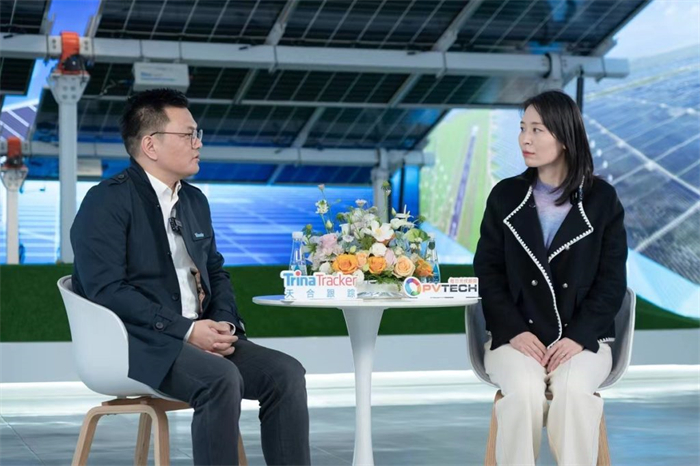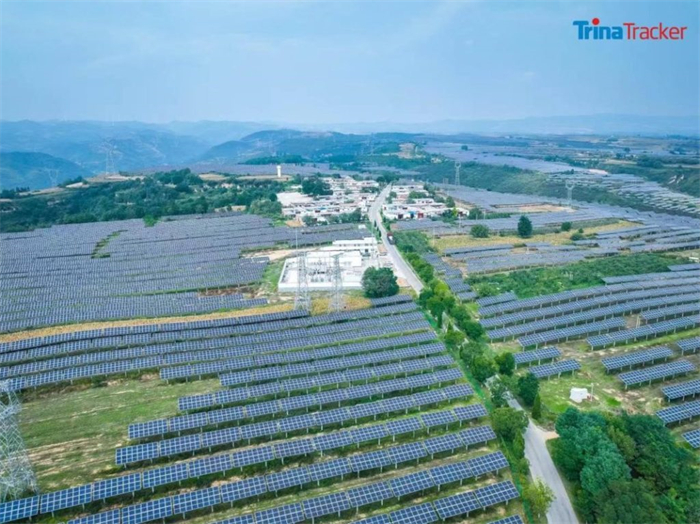
“We are optimistic about the scale of this year’s global tracker market, and expect it to maintain a 20-30% growth over the whole period, with individual markets such as Europe and China continuing to grow,” said Duan Shunwei, VP of Trina Solar’s tracker division. Image: PV Tech.
As a key element in power generation systems, the performance of a solar tracker is becoming increasingly important, and the market scale for trackers is expanding, with the sector entering a new development cycle.
According to China Photovoltaic Industry Association (CPIA) data, the past two years have seen the global tracker market reach an annual deployment of 50GW. Looking further into 2023, with stable module prices combined with a steady decline in steel and logistics costs, analysts are predicting that the size of the market will rise to 70GW, and increase further to reach 150GW in 2027.
The global PV tracker industry has long been dominated by mostly American and European companies, which account for about half of the market.
TrinaTracker entered the sector with the acquisition of the established Spanish manufacturer Nclave in 2020. Since then, the company has been engaged in a period of continual technological innovation and M&A, with the result that its products and market strategy were in synergy, enabling it to make a significant breakthrough in Europe.
In addition to the traditional markets for tracker manufacturers, new opportunities are now emerging in countries and regions including Brazil, China and the Middle East, all of which have developed rapidly over recent years.
TrinaTracker is formulating a strategy to take advantage of new opportunities. Duan Shunwei, VP of Trina Solar’s tracker division, told PV Tech in an interview: “We have made some important progress in the Latin American market and we are currently working with Samsung on a very big project in the Middle East. We are also hoping to make a breakthrough in the US market.”
Another area of considerable potential is China, with the Chinese tracker market gaining momentum despite a relatively low current penetration rate of 10%-15%. Duan is very optimistic about the Chinese market. “Although the domestic tracker market is not large at present, there is a lot of potential for growth. TrinaTracker is the leading player in China and, with the growth of the domestic market, our market share will also increase. China is also home to our global headquarters, so we have unique advantages both in terms of R&D and supply chain.”
Backed by the strength of Trina Solar, the company enjoys obvious advantages in the Chinese market. So, what is its strategic position within Trina Solar’s overall business landscape?
Duan: “Trina Solar is currently promoting a 1+3+n business principle. ‘1’ is the module, and the first part of ‘3’ is the tracker. Trackers, therefore represent a very important part of the Trina Solar Group’s business strategy. Looking forward, we can see that Trina now has modules, trackers and also an energy storage business. Horizontal product integration is a fundamental element of our approach. We think about how to create value from the customer perspective through the integration of hardware, including becoming a smart solution provider, which I believe is a powerful concept.”
TrinaTracker has shipped more than 9GW of its products to date, with growth doubling every year.

Trina’s smart trackers deployed in Northwest China. Image: TrinaTracker.
With the construction of large plants in increasingly complex and diverse locations, the PV industry has entered a new phase of development in which site selection has become more challenging. Sloping and uneven terrain, deserts and beaches are now more commonplace, which places more stringent requirements on equipment.
As the ‘backbone’ of a power plant, trackers play a key role in the overall system, so how can plant owners and developers be supported in deploying in complex landscapes?
“Trina Solar has always been customer-oriented, focusing on ways to create additional value. In order to deal with complex landscapes, we have carried out research from different standpoints. The first is product design – actively exploring the standard design for different terrains. The second is by working on certain components, such as spherical bearings, which can be adapted to almost any terrain,” Duan continued.
He adds that difficult terrain can also present an opportunity. “Because we have been researching and coming up with an effective combination of bi-facial modules and trackers under complex terrain conditions to increase power generation to the maximum, our self-developed smart algorithm has become a basic idea for us.”
Driven by market demand, TrinaTracker has upgraded its trackers to a smarter level. The smart control system introduced, different from traditional trackers, integrates software and hardware in one, including an intelligent algorithm (STA, SBA), multi-source data and a smart O&M monitoring platform.
There are a number of system integrators in the PV industry with the capability to produce trackers, but few can make them smart with advanced algorithms and then mass-produce them.
“From ‘tracker’ to ‘smart tracker’, we have been committed to continued innovation and integrated development. Based on the knowledge accumulated, we have been able to overcome the shortcomings of tracker applications in power plants and promote the high-quality development of integrated plant solutions,” says Duan.
Cost reduction and efficiency enhancement have always been at the core of the development of the PV industry, and smart trackers follow the same objectives. As module prices fall, a power plant’s focus will gradually shift from initial investment to the long-term profitability of the plant.
Duan introduced the company’s ‘new path’ to improve the efficiency of smart trackers. From the comprehensive consideration of product design based on terrain, climate, ground characteristics, construction, installation, operation and maintenance conditions for a specific location to the collection and analysis of tracker application data, the set of considerations provides a valuable reference point for cost reduction and efficiency improvement.
“For example,” he said, “one of our power plants in the west of China improved its power generation gain by more than 3% after adopting the smart algorithm. Third-party verification has shown an increase in IRR of some 0.5% over the whole life cycle of the plant. We have also received a lot of positive customer feedback on projects we have delivered, since the increase in power generation can be clearly seen.”
Looking forward, the growth of power plant projects in emerging markets around the world will see a logical increase in the deployment of trackers. Duan is confident about future prospects for the sector.
“Guided by customer demand, we will explore further opportunities to develop the industry and create a healthy competitive environment. We hope to see Chinese tracker manufacturers upgrade their technical specifications so that more people can appreciate the importance of smart trackers to both the domestic and international industry,” he concluded.
